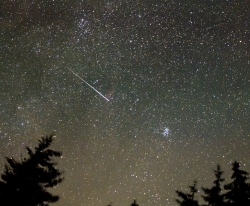Audio: mp3 

Cover Courtesy & Copyright © 2009 The Penguin Group
Holly: Hi, I’m Holly Strand from Stokes Nature Center in beautiful Logan Canyon.
Christopher Cokinos is the author of a new book, The Fallen Sky, published by the Penguin Group Press. It’s the story of meteorites and the impressions that meteorites make on the Earth and in the people who seek them out. Here’s Chris talking about falling stars:
Chris: On any clear night, under a dark enough sky, we can see shooting stars. We wish upon them even if we may not know what they are. It’s as if we’re eager to pin our chances on something strange and sudden.
A shooting star is not a star; it’s a meteor—the bright passage of a small grain or rock burning up through the air as it descends from space. If it’s big enough, it may drop a rock on the Earth itself—then it becomes a meteorite. In space, these objects are called meteoroids.
Every mid-August, our skies are graced by a shower of shooting stars—the Perseids. This is when Earth intersects the spindrift tail of the disintegrated Comet Swift-Tuttle, and we see these dusty grains streaking through the sky, too small to ever reach us.
They’re called the Perseids because the meteors appear to originate from the constellation Perseus, but these shooting stars can appear in any part of the sky.
Meteors travel very fast, from between 7 miles per second to 44 miles per second, and even one the size of a raisin can produce a huge fireball.
But if you see one that big during the Perseids, it’s not a Perseid—it’s a random meteor, originating from the asteroid belt or even the Moon or Mars.
This year, the moon will interfere with viewing the shower, but you can still see quite a few Perseids from the late evening of August 11 through the morning of August 12.
The best way to watch is to recline on the ground or on a chaise so you have a wide view of the sky, preferably away from city lights. Have snacks, water and appropriate clothing and maybe some bug spray. Don’t use binoculars or a telescope as they restrict your field of view.
To learn how to make simple but scientifically useful observations, go to the American Meteor Society website at www.amsmeteors.org.
Of course, though it may not be scientifically useful, when you see a shooting star—feel free to make a wish.
Holly: Thanks, Chris. For listeners in the Logan area, check out the Star Party at the American West Heritage Center on August 14th. For more details see awhc.org
For Wild About Utah and Stokes Nature Center, I’m Holly Strand.
Credits:
Image: Book Cover Courtesy & Copyright © 2009 The Penguin Group
Text: Chris Cokinos
Sources & Additional Reading:
Cokinos, Christopher. 2009. The Fallen Sky: An Intimate History of Shooting Stars. Penguin Group, Inc.
“Weaving natural history, memoir, and the stories of maverick scientists, daring adventurers, and stargazing dreamers, this epic work takes us from Antarctica to outer space to tell the tale of how the study of meteorites became a scientific passion.”
https://www.amazon.com/Fallen-Sky-Intimate-History-Shooting/dp/1585428329 (Accessed August 11, 2009)
https://www.amazon.com/Fallen-Sky-Intimate-History-Shooting/dp/1585427209

